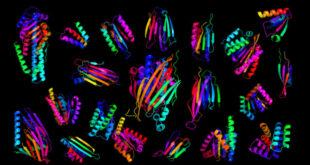A team of researchers at the College of Science at George Mason University has detected 48 antimicrobial peptides in the blood plasma of Komodo dragons (Varanus komodoensis), the largest living lizards. The discovery could lead to the development of new drugs capable of combating antibiotic-resistant bacteria.
The Komodo dragon (Varanus komodoensis). Image credit: Jason Buchner.
Komodo dragons live in the lesser Sunda region of the Indonesian archipelago, including the islands of Komodo, Flores, Rinca, and Padar.
The saliva of these lizards contains more than 50 species of aerobic and anaerobic bacteria (e.g. Enterobacteriaceae, Staphylococcus sciuri, Enterococcus faecalis), which are believed to contribute to the demise of their prey.
Yet, Komodo dragons appear resistant to these bacteria, and serum from these creatures has been shown to have antibacterial activity.
“Komodo dragons are the largest living lizards and are the apex predators in their environs,” said George Mason University researcher Barney Bishop and co-authors.
“They endure numerous strains of pathogenic bacteria in their saliva and recover from wounds inflicted by other dragons, reflecting the inherent robustness of their innate immune defense.”
Substances known as cationic antimicrobial peptides (CAMPs) are produced by nearly all living creatures and are an essential part of the innate immune system.
So, Dr. Bishop and his colleagues wondered whether they could isolate CAMPs from Komodo dragon blood, as they previously had done with alligator blood to expand the library of known CAMPs for therapeutic studies.
The researchers used an approach known as bioprospecting.
They incubated Komodo dragon blood with negatively charged hydrogel particles that they developed to capture the peptides, which are positively charged.
With this method, the team identified and sequenced 48 potential CAMPs with mass spectrometry.
All but one of these was derived from histone proteins, which are known to have antimicrobial activities.
“We employed a custom bioprospecting approach combining partial de novo peptide sequencing with transcriptome assembly to identify cationic antimicrobial peptides from Komodo dragon plasma,” the authors explained.
“Through these analyses, we identified 48 novel potential cationic antimicrobial peptides. All but one of the identified peptides were derived from histone proteins.”
“The antimicrobial effectiveness of eight of these peptides was evaluated against Pseudomonas aeruginosa and Staphylococcus aureus, with seven peptides exhibiting antimicrobial activity against both microbes, and one only showing significant potency against P. aeruginosa.”
The researchers conclude that Komodo dragon blood plasma contains a host of potentially viable antimicrobial peptides that could help lead to new therapeutics.
The team’s findings were published online Feb. 6, 2017 in the Journal of Proteome Research.
_____
Barney M. Bishop et al. Discovery of Novel Antimicrobial Peptides from Varanus komodoensis (Komodo dragon) by Large Scale Analyses and De Novo-Assisted Sequencing using Electron Transfer Dissociation Mass Spectrometry. J. Proteome Res., published online February 6, 2017; doi: 10.1021/acs.jproteome.6b00857
 #Bizwhiznetwork.com Innovation ΛI |Technology News
#Bizwhiznetwork.com Innovation ΛI |Technology News




